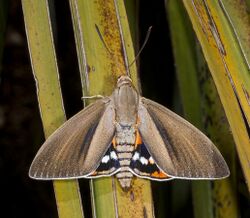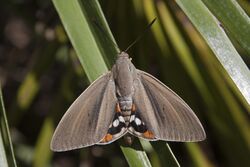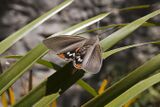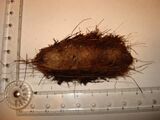Biology:Paysandisia archon
| Paysandisia archon | |
|---|---|

| |
| P. archon male | |

| |
| P. archon female | |
| Scientific classification | |
| Domain: | Eukaryota |
| Kingdom: | Animalia |
| Phylum: | Arthropoda |
| Class: | Insecta |
| Order: | Lepidoptera |
| Family: | Castniidae |
| Subfamily: | Castniinae |
| Tribe: | Gazerini |
| Genus: | Paysandisia Houlbert, 1912 |
| Species: | P. archon
|
| Binomial name | |
| Paysandisia archon (Burmeister, 1880)
| |
| Synonyms | |
| |
Paysandisia archon is a moth of the family Castniidae. It is native to Uruguay and central Argentina and has been accidentally introduced to Europe, where it is spreading rapidly. It is considered the only member of the genus Paysandisia.
German naturalist Hermann Burmeister described the species in 1879 as Castnia archon.
This is a very large moth with a wingspan of 90–110 mm. The forewings are dark green with brown streaking, the hindwings are bright red with bold black and white markings. The females, generally larger than the males, are easily recognized by the prominent ovipositor. Like other castniids, this species flies by day and has clubbed antennae and is easily mistaken for a butterfly. The adults fly from June to September.
The larva is whitish and maggot-like and feeds in the stems and trunks of palms (see list below for recorded food plants). In its natural range, the damage done by the larvae is unobtrusive and the species is not considered a pest but the species is causing increasing concern in Europe because of the sometimes fatal damage being caused to native and exotic palms. The species pupates in a cocoon incorporating palm fibres within the larval gallery.
Invasive species
Since arriving in the Southern France in the mid-1990s (probably in mature specimens of Trithrinax from Argentina), it has spread along the Mediterranean coast to parts of Spain, Italy, Greece and Cyprus[1][2] and it is feared that without effective control, it could spread to areas where palms grow throughout the region. (It is absent from Albania but global warming may make it suitable habitat in 2020–2039.)[2]
One has also been reported from England, in West Sussex in 2002 and 2009 in Northern Ireland.[2] Both UK introductions were eradicated.[2] A survey shows it is absent from the Netherlands.[2] The species was first reported on Russia's Black Sea coast in 2014,[3] and by 2016 had been implicated in the death of over 200 palm trees in Sochi.[4]
Recorded food plants
Natural range
Introduced range
- Chamaerops
- Livistona spp., including:
- L. chinensis
- L. decipiens
- L. saribus
- Phoenix spp., including:
- P. canariensis
- P. dactylifera
- P. reclinata
- Sabal
- Trachycarpus fortunei
- Washingtonia spp., including:
Gallery
-
Habitat
-
Larva (80 mm) of Paysandisia archon in its gallery
-
Larva
-
Cocoon
-
Pupa
-
Damage on palm trees by Paysandisia archon larvae
-
Paysandisia archon in South West France
Notes
- ↑ Research Gate: First report of the palm borer Paysandisia archon (Burmeister 1880) (Lepidoptera: Castniidae) in Cyprus
- ↑ 2.0 2.1 2.2 2.3 2.4 Muñoz‐Adalia, Emigdio Jordán; Colinas, Carlos (2020-03-18). "The invasive moth Paysandisia archon in Europe: Biology and control options". Journal of Applied Entomology (Wiley) 144 (5): 341–350. doi:10.1111/jen.12746. ISSN 0931-2048.
- ↑ Карпун, Н. Н.; Игнатова, Е. А.; Журавлёва, Е. Н. (2015). (in Russian)Известия Санкт-Петербургской лесотехнической академии (211): 187–203. http://spbftu.ru/UserFiles/Image/izvesti/14-211.pdf. Retrieved 29 October 2017.
- ↑ Фунтиков, Илья (16 May 2017). "Error: no
|title=specified when using {{Cite web}}" (in Russian). https://sochinews.io/2017/05/16/palmovyiy-motyilek-ognevka-listobloshka-i-drugie/. Retrieved 29 October 2017.
References
- Palm Threat in France? (Inra)
- EPPO Quarantine Alert: Paysandisia archon
- https://web.archive.org/web/20180408043255/http://www.lepido-france.fr/pdf/BLP_n_22_merit_paysandisia_archon.pdf
- Blog Paysendisia Archon - Barrenador palmeras (in Spanish)
External links
| Wikimedia Commons has media related to Paysandisia archon. |
Wikidata ☰ Q140386 entry
 |








